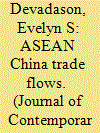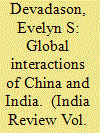|
|
|
Sort Order |
|
|
|
Items / Page
|
|
|
|
|
|
|
| Srl | Item |
| 1 |
ID:
098100


|
|
|
|
|
| Publication |
2010.
|
| Summary/Abstract |
There are claims that China's influence on ASEAN is direct in that she has encouraged more exports to flow into her huge markets and changed trade flows amongst member countries. Demand and supply are deemed to have therefore become more China-centred. This paper looks at the plausibility of China as a 'factor' that influences bilateral intra-ASEAN trade flows through demand (exporting country) and supply (partner country). The key finding of the study is that China's trade association with the region increases intra-ASEAN exports. China is therefore the most practical choice for the ASEAN+1 FTA to initiate deeper trade integration within the region. China, as the 'core' country of the ACFTA can provide complementarities in the export performance of ASEAN.
|
|
|
|
|
|
|
|
|
|
|
|
|
|
|
|
| 2 |
ID:
156968


|
|
|
|
|
| Summary/Abstract |
The paper reviews and assesses the performance of the manufacturing sector in general, as well as the catalytic industries identified in the Eleventh Malaysia Plan (11MP), to ascertain whether the initiatives and targets proposed in the Plan are adequate to energize and move the sector forward. In doing so, the paper uses industrial policy arguments — market and government failures — to explain the slow progress of the sector. The findings suggest that market failures — in terms of lagging industrial capabilities and economies of scale, market frictions, lack of support for self-discovery by firms and diversification — require government intervention. Nevertheless, defying comparative advantage and identifying frontier products that show lacklustre performance to spearhead the sector under the Plan certainly require substantial improvements in institutional capabilities, coordination and institutional learning, while maintaining respect for markets and incentives. The paper concludes that lack of recognition to address government failures limited the success of policies implemented.
|
|
|
|
|
|
|
|
|
|
|
|
|
|
|
|
| 3 |
ID:
116673


|
|
|
| 4 |
ID:
147368


|
|
|
|
|
| Summary/Abstract |
This article explores the global positions of China and India in merchandise trade. It first compares the integration models of China and India and, thereafter, examines the core factors that drive their trading relationships. With respect to their global trading partners, there are considerable differences in the influence of economic drivers of trade for China and India. Combined larger markets, similar consumer preferences, similar factor endowments and linguistic links enhance global exports from China. Alternatively, smaller market size, discrepancy in consumer demands, dissimilar factor endowments and combined stocks of foreign direct investments drive India’s global trade. The findings suggest that differences in the structure and demand of China vis-a-vis India dictate the divergence in the profile of their trade determinants. Such divergence in trade drivers, however, dissipates when taking into account Chinese and Indian partnerships on a regional basis – with East Asia, Middle East and North Africa (MENA), Latin America, European Union (EU), and Africa.
|
|
|
|
|
|
|
|
|
|
|
|
|
|
|
|
| 5 |
ID:
130418


|
|
|
|
|
| Publication |
2014.
|
| Summary/Abstract |
The Trans-Pacific Partnership (TPP) was accepted by the Asia Pacific Economic Cooperation (APEC) as one among other pathfinders, for a comprehensive Free Trade Area of the Asia Pacific (FTAAP). Though the TPP negotiations do not include China at the moment, she has declared her interest in the TPP and is paying close attention to it. In fact, many question the likely success of the TPP with China's exclusion from it, given her prominence in the region. To provide insights for leveraging trade opportunities with the TPP economies, China's export potentials with the TPP are empirically tested and compared with those of alternative economic configurations in East Asia which China is a party to, namely the ASEAN+1, ASEAN+3 and ASEAN+6. The empirical findings suggest that China's participation in the TPP will offer better market access for final goods, an important trade opportunity that is somewhat limited in partnerships through regional initiatives. Even then, the paper contends that the payoffs to China following the TPP deal remain intangible and at best speculative given the coverage (or substance) and depth of the agreement.
|
|
|
|
|
|
|
|
|
|
|
|
|
|
|
|
|
|
|
|
|